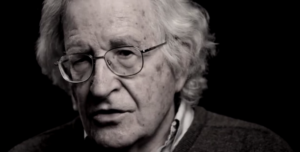Interview With Noam Chomsky On The State Of The World
We live in a world facing existential threats while extreme inequality is tearing our societies apart and democracy is in sharp decline. The U.S., meanwhile, is bent on maintaining global hegemony when international collaboration is urgently needed to address the planet’s numerous challenges. In the interview that follows, Noam Chomsky explains why we are at the most dangerous point in human history and why nationalism, racism, and extremism are rearing their ugly heads all over the world today.
Chomsky is institute professor emeritus in the Department of Linguistics and Philosophy at MIT and laureate professor of linguistics and Agnese Nelms Haury Chair in the Program in Environment and Social Justice at the University of Arizona. One of the world’s most-cited scholars and a public intellectual regarded by millions of people as a national and international treasure, Chomsky has published more than 150 books in linguistics, political and social thought, political economy, media studies, U.S. foreign policy, and world affairs. His latest books are Illegitimate Authority: Facing the Challenges of Our Time (with C. J. Polychroniou; Haymarket Books); The Secrets of Words (with Andrew Moro; MIT Press, 2020); The Withdrawal: Iraq, Libya, Afghanistan, and the Fragility of U.S. Power (with Vijay Prashad; The New Press, 2022); and The Precipice: Neoliberalism, the Pandemic, and the Urgent Need for Social Change (with C. J. Polychroniou; Haymarket Books, 2021).
C. J. Polychroniou: Noam, you have said on numerous occasions that the world is at the most dangerous point in human history. Why do you think so? Are nuclear weapons more dangerous today than they were in the past? Is the surge in right-wing authoritarianism in recent years more dangerous than the rise and subsequent spread of fascism in the 1920s and 1930s? Or is it because of the climate crisis, which you have indeed said that it represents the biggest threat the world has ever faced. Can you explain in comparative terms why you think that the world is today significantly more dangerous than it used to be?
Noam Chomsky: The climate crisis is unique in human history and is getting more severe year by year. If major steps are not taken within the next few decades, the world is likely to reach a point of no return, facing decline to indescribable catastrophe. Nothing is certain, but this seems a far too plausible assessment.
Weapons systems steadily become more dangerous and more ominous. We have been surviving under a sword of Damocles since the bombing of Hiroshima. A few years later, 70 years ago, the U.S., then Russia, tested thermonuclear weapons, revealing that human intelligence had “advanced” to the capacity to destroy everything.
Operative questions have to do with the sociopolitical and cultural conditions that constrain their use. These came ominously close to breaking down in the 1962 missile crisis, described by Arthur Schlesinger as the most dangerous moment in world history, with reason, though we may soon reach that unspeakable moment again in Europe and Asia. The MAD system (mutually assured destruction) enabled a form of security, lunatic but perhaps the best short of the kind of social and cultural transformation that is still unfortunately only an aspiration.
After the collapse of the Soviet Union, the MAD system of security was undermined by Clinton’s aggressive triumphalism and the Bush II-Trump project of dismantling the laboriously constructed arms control regime. There’s an important recent study of these topics by Benjamin Schwartz and Christopher Layne, as part of the background to Russia’s invasion of Ukraine. They review how Clinton initiated a new era of international affairs in which the “United States became a revolutionary force in world politics” by abandoning the “old diplomacy” and instituting its preferred revolutionary concept of global order.
The “old diplomacy” sought to maintain global order by “an understanding of an adversary’s interests and motives and an ability to make judicious compromises.” The new triumphant unilateralism sets as “a legitimate goal [for the US] the alteration or eradication of those arrangements [internal to other countries] if they were not in accord with its professed ideals and values.”
The word “professed” is crucial. It is commonly expunged from consciousness here, not elsewhere.
In the background lies the Clinton doctrine that the U.S. must be prepared to resort to force, multilaterally if we can, unilaterally if we must, to ensure vital interests and “uninhibited access to key markets, energy supplies and strategic resources.”
The accompanying military doctrine has led to creation of a far more advanced nuclear weapons system that can only be understood as “a preemptive counterforce capability against Russia and China” (Rand Corporation) – a first-strike capacity, enhanced by Bush’s dismantling of the treaty that barred emplacement of ABM systems near an adversary’s borders. These systems are portrayed as defensive, but they are understood on all sides to be first-strike weapons.
These steps have significantly weakened the old system of mutual deterrence, leaving in its place greatly enhanced dangers.
How new these developments were, one might debate, but Schwartz and Layne make a strong case that this triumphant unilateralism and open contempt for the defeated enemy has been a significant factor in bringing major war to Europe with the Russian invasion of Ukraine, with the potential to escalate to terminal war.
No less ominous are developments in Asia. With strong bipartisan and media support, Washington is confronting China on both military and economic fronts. With Europe safely in its pocket thanks to Russia’s invasion of Ukraine, the U.S. has been able to expand NATO to the Indo-Pacific region, thus enlisting Europe in its campaign to prevent China from developing – a program considered not just legitimate but highly praiseworthy. One of the administration doves, Commerce Secretary Gina Raimondo, expressed the consensus lucidly: “If we really want to slow down China’s rate of innovation, we need to work with Europe.”
It’s particularly important to keep China from developing sustainable energy, where it is far in the lead and should reach energy self-sufficiency by 2060 according to Goldman Sachs analysts. China is even threatening to make new breakthroughs in batteries that might help save the world from climate catastrophe.
Plainly a threat that must be contained, along with China’s insistence on the One-China policy for Taiwan that the U.S. also adopted 50 years ago and that has kept the peace for 50 years, but that Washington is now rescinding. There’s much more to add that reinforces this picture, matters we have discussed elsewhere.
It’s hard to say the words in this increasingly odd culture, but it’s close to truism that unless the U.S. and China find ways to accommodate, as great powers with conflicting interests often did in the past, we are all lost.
Historical analogies have their limits of course, but there are two pertinent ones that have repeatedly been adduced in this connection: The Concert of Europe established in 1815 and the Versailles treaty of 1919. The former is a prime example of the “Old Diplomacy.” The defeated aggressor (France) was incorporated into the new system of international order as an equal partner. That led to a century of relative peace. The Versailles treaty is a paradigm example of the “revolutionary” concept of global order instituted by the triumphalism of the ‘90s and its aftermath. Defeated Germany was not incorporated into the postwar international order but was severely punished and humiliated. We know where that led.
Currently, two concepts of world order are counterposed: the UN system and the “rules-based” system, correlating closely with multipolarity and unipolarity, the latter meaning U.S. dominance.
The U.S. and its allies (or “vassals” or “subimperial states” as they are sometimes called) reject the UN system and demand adherence to the rules-based system. The rest of the world generally supports the UN system and multipolarity.
The UN system is based on the UN Charter, the foundation of modern international law and the “supreme law of the land” in the U.S. under the U.S. Constitution, which elected officials are bound to obey. It has a serious defect: it rules out U.S. foreign policy. Its core principle bans “the threat or use of force” in international affairs, except in narrow circumstances unrelated to U.S. actions. It would be hard to find a U.S. postwar president who has not violated the U.S. Constitution, a topic of little interest, the record shows.
What is the preferred rules-based system? The answer depends on who sets the rules and determines when they should be obeyed. The answer is not obscure: the hegemonic power, which took the mantle of global dominance from Britain after World War II, greatly extending its scope.
One core foundation stone of the U.S.-dominated rules-based system is the World Trade Organization. We can ask, then, how the U.S. honors it.
As global hegemon, the U.S. is alone in capacity to impose sanctions. These are third-party sanctions that others must obey, or else. And they do obey, even when they strongly oppose the sanctions. One example is the U.S. sanctions designed to strangle Cuba. These are opposed by the whole world as we see from regular UN votes. But they are obeyed.
When Clinton instituted sanctions that were even more savage than before, the European Union called on the WTO to determine their legality. The U.S. angrily withdrew from the proceedings, rendering them null and void. There was a reason, explained by Clinton’s Commerce Secretary Stuart Eizenstat: “Mr. Eizenstat argued that Europe is challenging ‘three decades of American Cuba policy that goes back to the Kennedy Administration,’ and is aimed entirely at forcing a change of government in Havana.”
In short, Europe and the WTO have no competence to influence the long-standing U.S. campaign of terror and economic strangulation aimed at forcefully overthrowing the government of Cuba, so they should get lost. The sanctions prevail, and Europe must obey them – and does. A clear illustration of the nature of the rules-based order.
There are many others. Thus, the World Court ruled that U.S. freezing of Iranian assets is illegal. It scarcely caused a ripple.
That is understandable. Under the rules-based system, the global enforcer has no more reason to accede to ICJ judgments than to decisions of the WTO. That much was established years ago. In 1986, the U.S. withdrew from ICJ jurisdiction when it condemned the U.S. for its terrorist war against Nicaragua and ordered it to pay reparations. The U.S. responded by escalating the war.
To mention another illustration of the rules-based system, the U.S. alone withdrew from the proceedings of the Tribunal considering Yugoslavia’s charges against NATO. It argued correctly that Yugoslavia had mentioned genocide, and the U.S. is self-exempted from the international treaty banning genocide.
It’s easy to continue. It’s also easy to understand why the U.S. rejects the UN-based system, which bans its foreign policy, and prefers a system in which it sets the rules and is free to rescind them when it wishes. There’s no need to discuss why the U.S. prefers a unipolar rather than multipolar order.
All of these considerations arise critically in consideration of global conflicts and threats to survival.
CJP: All societies have seen dramatic economic transformations over the past 50 years, with China leading the pack as it emerged in just the course of just a few decades from an agrarian society into an industrial powerhouse, lifting in the process hundreds of millions out of poverty. But this is not to say that life is necessarily an improvement over the past. In the U.S., for instance, the quality of life has declined over the past decade and so has life satisfaction in the European Union. Are we at a stage where we are witnessing the decline of the West and the rise of the East? In either case, while many people seem to think that the rise of the far-right in Europe and the United States is related to perceptions about the decline of the West, the rise of the far-right is a global phenomenon, ranging from India and Brazil to Israel, Pakistan and the Philippines. In fact, the alt-right has even found a comfortable home on China’s internet. So, what’s going on? Why are nationalism, racism and extremism making such a huge comeback on the world stage at large?
NC: There is an interplay of many factors, some specific to particular societies, for example, the dismantling of secular democracy in India as Prime Minister Modi pursues his project of establishing a harsh racist Hindu ethnocracy. That’s specific to India, though not without analogues elsewhere.
There are some factors that have fairly broad scope, and common consequences. One is the radical increase in inequality in much of the world as a consequence of the neoliberal policies emanating from the U.S. and UK and spreading beyond in various ways.
The facts are clear enough, particularly well-studied for the U.S. The Rand corporation study we’ve discussed before estimated almost $50 trillion in wealth transferred from workers and the middle class – the lower 90% of income – to the top 1% during the neoliberal years. More information is provided in the work of Thomas Piketty and Emanuel Saez, summarized lucidly by political economist Robert Brenner.
The basic conclusion is that through “the postwar boom, we actually had decreasing inequality and very limited income going to the top income brackets. For the whole period from the 1940s to the end of the 1970s, the top 1% of earners received 9-10% of total income, no more. But in the short period since 1980, their share, that is the share of the top 1%, has gone up to 25%, while the bottom 80% have made virtually no gains.”
That has many consequences. One is reduction of productive investment and shift to a rentier economy, in some ways a reversion from capitalist investment for production to feudal-style production of wealth, not capital – “fictitious capital,” as Marx called it.
Another consequence is breakdown of the social order. In their incisive work The Spirit Level, Richard Wilkinson and Kate Pickett show a close correlation between inequality and a range of social disorders. One country is off the chart: very high inequality but even greater social disorder than expected by the correlation. That’s the country that led the way in the neoliberal assault – formally defined as commitment to small government and the market, in practice radically different, more accurately described as dedicated class war making use of whatever mechanisms are available.
Wilkinson-Pickett’s revealing work has been carried forward since, recently in an important study by Steven Bezruchka. It seems well confirmed that inequality is a prime factor in breakdown of social order.
There have been similar effects in the UK under harsh austerity policies, extending elsewhere in many ways. Commonly, the hardest hit are the weak. Latin America suffered two lost decades under destructive structural adjustment policies. In Yugoslavia and Rwanda such policies in the ‘80s sharply exacerbated social tensions, contributing to the horrors that followed.
It’s sometimes argued the neoliberal policies were a grand success, pointing to the fastest reduction in global poverty in history — but failing to add that these remarkable achievements were in China and other countries that firmly rejected the prescribed neoliberal principles.
Furthermore, it wasn’t the “Washington consensus” that induced U.S. investors to shift production to countries with much cheaper labor and limited labor rights or environmental constraints, thereby deindustrializing America with well-known consequences for working people.
It is not that these were the only options. Studies by the labor movement and by Congress’s own research bureau (OTA, since disbanded) offered feasible alternatives that could have benefited working people globally. But they were dismissed.
All of this forms part of the background for the ominous phenomena you describe. The neoliberal assault is a prominent factor in the breakdown of the social order that leaves great numbers of people angry, disillusioned, frightened, contemptuous of institutions that they see are not working in their interests.
One crucial element of the neoliberal assault has been to deprive the targets of means of defense. Reagan and Thatcher opened the neoliberal era with attacks on unions, the main line of defense of working people against class war. They also opened the door to corporate attacks on labor, often illegal, but that doesn’t matter when the state they largely control looks the other way.
A primary defense against class war is an educated, informed public. Public education has come under harsh attack during the neoliberal years: sharp defunding, business models that favor cheap and easily disposable labor (adjuncts, graduate students) instead of faculty, teaching-to-test models that undermine critical thinking and inquiry, and much else. Best to have a population that is passive, obedient and atomized, even if they are angry and resentful, and thus easy prey for demagogues skilled in tapping ugly currents that run not too far below the surface in every society.
CJP: We have heard on countless occasions from both political pundits and influential academics that democracy is in decline. Indeed, the Economist Intelligence Unit (EIU) claimed in early 2022 that just only 6.4% of the world’s population enjoys “full democracy,” though it is anything but clear how the sister company of the conservative weekly magazine The Economist understands the actual meaning and context of the term “full democracy.” Be that as it may, I think we can all agree that there are several key indicators pointing to a dysfunction of democracy in the 21st century. But isn’t it also the case that a perception of a crisis of democracy has existed almost as long as modern democracy itself? Moreover, isn’t it also the case that general talk about a crisis of democracy applies exclusively to the concept of liberal democracy, which is anything but authentic democracy? I am interested in your thoughts on these topics.
NC: What exactly is a crisis of democracy? The term is familiar. It was, for example, the title of the first publication of the Trilateral Commission, liberal internationalist scholars from Europe, Japan, and the U.S. It stands alongside the Powell Memorandum as one of the harbingers of the neoliberal assault that was gathering steam in the Carter administration (mostly trilateralists) and took off with Reagan and Thatcher. The Powell memorandum, addressing the business world, was the tough side; the Trilateral Commission report was the soft liberal side.
The Powell memorandum, authored by Justice Lewis Powell, pulled no punches. It called on the business world to use its power to beat back what it perceived as a major attack on the business world – meaning that instead of the corporate sector freely running almost everything, there were some limited efforts to restrict its power. The streak of paranoia and wild exaggerations are not without interest, but the message was clear: Launch harsh class war and put an end to the “time of troubles,” a standard term for the activism of the 1960s, which greatly civilized society.
Like Powell, the Trilateralists were concerned by the “time of troubles.” The crisis of democracy was that ‘60s activism was bringing about too much democracy. All sorts of groups were calling for greater rights: the young, the old, women, workers, farmers,…, sometimes called “special interests.” A particular concern was the failure of the institutions responsible “for the indoctrination of the young”: schools and universities. That’s why we see young people carrying out their disruptive activities. These popular efforts imposed an impossible burden on the state, which could not respond to these special interests: a crisis of democracy.
The solution was evident: “more moderation in democracy.” In other words, a return to passivity and obedience so that democracy can flourish. That concept of democracy has deep roots, going back to the Founding Fathers and Britain before them, revived in major work on democratic theory by 20th century thinkers, among them Walter Lippmann, the most prominent public intellectual; Edward Bernays, a guru of the huge public relations industry; Harold Lasswell, one of the founders of modern political science; Reinhold Niebuhr, known as the theologian of the liberal establishment.
All were good Wilson-FDR-JFK liberals. All agreed with the Founders that democracy was a danger to be avoided. The people of the country have a role in a properly functioning democracy: to push a lever every few years to select someone offered to them by the “responsible men.” They are to be “spectators, not participants,” kept in line with “necessary illusions” and “emotionally potent oversimplifications,” what Lippmann called “manufacture of consent,” a primary art of democracy.
Satisfying these conditions would constitute “full democracy,” as the concept is understood within liberal democratic theory. Others may have different views, but they are part of the problem, not the solution, to paraphrase Reagan.
Returning the concerns about decline of democracy, even full democracy in this sense is in decline in its traditional centers. In Europe, Orban’s racist “illiberal democracy” in Hungary troubles the European Union, along with Poland’s ruling Law and Justice party and others that share its deeply authoritarian tendencies.
Recently Orban hosted a conference of far-right movements in Europe, some with neo-fascist origins. The U.S. National Conservative Political Action Caucus, a core element of today’s GOP, was a star participant. Donald Trump gave a major address. Tucker Carlson contributed an adoring documentary.
Shortly after, the NCPAC had a conference in Dallas Texas, where the keynote speaker was Victor Orban, lauded as a leading spokesman of authoritarian white Christian nationalism.
These are no laughing matters. At both the state and the national level, today’s Republican party in the U.S., which has abandoned its past role as an authentic parliamentary party, is seeking ways to gain permanent political control as a minority organization, committed to Orban-style illiberal democracy. Its leader, Donald Trump, has made no secret of his plans to replace the nonpartisan civil service that is a foundation of any modern democracy with appointed loyalists, to prevent teaching of American history in any minimally serious fashion, and in general to end vestiges of more than limited formal democracy.
In the most powerful state of human history, with a long, mixed, sometimes progressive democratic tradition, these are not minor matters.
CJP: Countries in the periphery of the global system seem to be trying to break away from Washington’s influence and are increasingly calling for a new world order. For instance, even Saudi Arabia is following Iran to join China and Russia’s security bloc. What are the implications of this realignment in global relations, and how likely is it that Washington will use tactics to halt this process from going much further?
NC: In March, Saudi Arabia joined the Shanghai Cooperation Organization. It was followed shortly after by the second Middle East petroleum heavyweight, the United Arab Emirates, which had already become a hub for China’s Maritime Silk Road, running from Kolkata in Eastern India through the Red Sea and on to Europe. These developments followed China’s brokering a deal between Iran and Saudi Arabia, previously bitter enemies, and thus impeding U.S. efforts to isolate and overthrow the regime. Washington professes not to be concerned, but that is hard to credit.
Since the discovery of oil in Saudi Arabia in 1938, and the recognition soon of its extraordinary scale, controlling Saudi Arabia has been a high priority for the U.S. Its drift towards independence — and even worse, towards the expanding China-based economic sphere — must be eliciting deep concern in policy-making circles. It’s another long step towards a multipolar order that that is anathema to the U.S.
So far, the U.S. had not devised effective tactics to counter these strong tendencies in world affairs, which have many sources – including the self-destruction of U.S. society and political life.
CJP: Organized business interests have had decisive influence on U.S. foreign policy over the last two centuries. However, there are arguments made today that there is a loosening of business hegemony over U.S. foreign policy, and China is offered as the evidence that Washington is not listening to business anymore. But isn’t it the case that the capitalist state, while always working on behalf of the general interests of the business establishment, also possesses a certain degree of independence and that other factors enter into the equation when it comes to the implementation of foreign policy and the management of foreign affairs? It seems to me that U.S. foreign policy towards Cuba, for example, is evidence of the relative autonomy of the state from the economic interests of the capitalist classes.
NC: It may be a caricature to describe the capitalist state as the executive committee of the ruling class, but it’s a caricature of something that exists, and has existed for a long time. We may recall again Adam Smith’s description of the early days of capitalist imperialism, when the “masters of mankind” who owned the economy of England were the “principal architects” of state policy and ensured that their own interests were properly served no matter how grievous the effects on others. Others included the people of England, but much more so the victims of the “savage injustice” of the masters, particularly in India in the early days of England’s destruction of what was then along with China the richest society on earth, while stealing its more advanced technology.
Some principles of global order have a long life.
There should be no need to review again how closely U.S. foreign policy has conformed to Smith’s maxim, to the present. One guiding doctrine is that the U.S. will not tolerate what State Department officials called “the philosophy of the new nationalism,” which embraces “policies designed to bring about a broader distribution of wealth and to raise the standard of living of the masses” along with the pernicious idea “that the first beneficiaries of the development of a country’s resources should be the people of that country.” They are not. The first beneficiaries are the investor class, primarily from the U.S.
This stern lesson was taught to backward Latin Americans at a hemispheric conference called by the U.S. in 1945, which established an Economic Charter for the Americas that stamped out these heresies. They were not confined to Latin America. 80 years ago, it seemed that at last the world would finally emerge from the misery of the Great Depression and fascist horrors. A wave of radical democracy spread throughout much of the world, with hopes for a more just and humane global order. The earliest imperatives for the U.S. and its British junior partner were to block these aspirations and to restore the traditional order, including fascist collaborators, first in Greece (with enormous violence) and Italy, then throughout western Europe, extending as well to Asia. Russia played as similar role in its own lesser domains. These are among the first chapters of postwar history.
While Smith’s masters of mankind quite generally ensure that state policy serves their immediate interests, there are exceptions, which give a good deal of insight into policy formation. We’ve just discussed one: Cuba. It’s not just the world that objects strenuously to the sanctions policy to which it must conform. The same is true of powerful sectors among the masters, including energy, agribusiness, and particularly pharmaceuticals, eager to link up with Cuba’s advanced industry. But the executive committee prohibits it. Their parochial interests are overridden by the long-term interest of preventing “successful defiance” of U.S. policies tracing back to the Monroe doctrine, as the State Department explained 60 years ago.
Any Mafia Don would understand.
The very same individual might make different choices as CEO of a corporation and in the State Department, with the same interests in mind but a different perspective on how to further them.
Another case is Iran, in this case going back to 1953, when the parliamentary government sought to gain control of its immense petroleum resources, making the mistake of believing “that the first beneficiaries of the development of a country’s resources should be the people of that country.” Britain, the longtime overlord of Iran, no longer had the capacity to reverse this deviation from good order, so called on the real muscle overseas. The U.S. overthrew the government, installing the Shah’s dictatorship, the first steps in U.S. torture of the people of Iran that has continued without a break to the present, carrying forward Britain’s legacy.
But there was a problem. As part of the deal, Washington demanded that U.S. corporations take over 40% of the British concession, but they were unwilling, for short-term parochial reasons. To do so would prejudice their relations with Saudi Arabia, where exploitation of the country’s resources was cheaper and more profitable. The Eisenhower administration threatened the companies with anti-trust suits, and they complied. Not a great burden to be sure, but one the companies didn’t want.
The conflict between Washington and U.S. corporations persists to the present. As in the case of Cuba, both Europe and U.S. corporations strongly oppose the harsh U.S. sanctions on Iran, but are forced to comply, cutting them out of the lucrative Iranian market. Again, the state interest in punishing Iran for successful defiance overrides the parochial interests of short-term profit.
Contemporary China is a much larger case. Neither European nor U.S. corporations are happy about Washington’s commitment “to slow down China’s rate of innovation” while they lose access to the rich China market. It seems that U.S. corporations may have found a way around the restrictions on trade. An analysis by the Asian business press found “a strong predictive relationship between these countries’ [Vietnam, Mexico, India] imports from China and their exports to the United States,” suggesting that trade with China has simply been re-directed.
The same study reports that “China’s share of international trade is rising steadily. Its export volume…rose 25% since 2018 while the industrial nations’ export volume stagnated.”
It remains to be seen how European, Japanese, and South Korean industries will react to the directive to abandon a primary market in order to satisfy the U.S. goal of preventing China’s development. It would be a bitter blow, far worse than losing access to Iran or of course Cuba.
CJP: More than a couple of centuries ago, Immanuel Kant presented his theory of perpetual peace as the only rational way for states to co-exist with one another. Yet, perpetual peace remains a mirage, an unattainable ideal. Could it be that a world political order away from the nation-state as the primary unit is a necessary prerequisite for perpetual peace to be realized?
NC: Kant argued that reason would bring about perpetual peace in a benign global political order. Another great philosopher, Bertrand Russell, saw things rather differently when asked about the prospects for world peace:
“After ages during which the earth produced harmless trilobites and butterflies, evolution progressed to the point at which it has generated Neros, Genghis Khans, and Hitlers. This, however, I believe is a passing nightmare; in time the earth will become again incapable of supporting life, and peace will return.”
I don’t presume to enter those ranks. I’d like to think that humans have the capacity to do much better than what Russell forecast, even if not to achieve Kant’s ideal.
Source: https://www.globalpolicyjournal.com/blog/26/05/2023/interview-noam-chomsky-state-world
C.J. Polychroniou is a political scientist/political economist, author, and journalist who has taught and worked in numerous universities and research centers in Europe and the United States. Currently, his main research interests are in U.S. politics and the political economy of the United States, European economic integration, globalization, climate change and environmental economics, and the deconstruction of neoliberalism’s politico-economic project. He is a columnist for Global Policy Journal and a regular contributor to Truthout as well as a member of Truthout’s Public Intellectual Project. He has published scores of books and over one thousand articles which have appeared in a variety of journals, magazines, newspapers and popular news websites. Many of his publications have been translated into a multitude of different languages, including Arabic, Chinese, Croatian, Dutch, French, German, Greek, Italian, Japanese, Portuguese, Russian, Spanish, and Turkish. His latest books are Optimism Over Despair: Noam Chomsky On Capitalism, Empire, and Social Change (2017); Climate Crisis and the Global Green New Deal: The Political Economy of Saving the Planet (with Noam Chomsky and Robert Pollin as primary authors, 2020); The Precipice: Neoliberalism, the Pandemic, and the Urgent Need for Radical Change (an anthology of interviews with Noam Chomsky, 2021); and Economics and the Left: Interviews with Progressive Economists (2021).


 On January 25, 2015, Greece’s left-wing party Syriza (Coalition of the Radical Left), which subscribed to no particular ideology but ran an election campaign that vowed to end the sadistic austerity measures that had been imposed on Greece by its international creditors, shred the bailout agreements into pieces, write off a big chuck of the debt, and create jobs for hundreds of thousands of unemployed, won the legislative elections by taking 36% of the popular vote. The result of the election sent shock waves through Europe’s political establishment and marked the return of hope for Greece and left-wing parties and movements around the world.
On January 25, 2015, Greece’s left-wing party Syriza (Coalition of the Radical Left), which subscribed to no particular ideology but ran an election campaign that vowed to end the sadistic austerity measures that had been imposed on Greece by its international creditors, shred the bailout agreements into pieces, write off a big chuck of the debt, and create jobs for hundreds of thousands of unemployed, won the legislative elections by taking 36% of the popular vote. The result of the election sent shock waves through Europe’s political establishment and marked the return of hope for Greece and left-wing parties and movements around the world.

